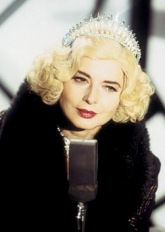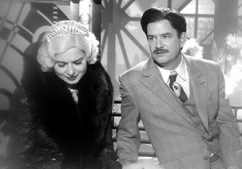| The Saddest Music in the World |
| |
 |
Canada, 2003. Not rated. 99 minutes.
Cast: Isabella Rossellini, Mark McKinney, Maria de Medeiros, Ross McMillan, David Fox, Claude Dorge, Darcy Fehr, Erik J. Berg
Writers: Guy Maddin and George Toles, based on the novel by Kazuo Ishiguro
Original Music: Christopher Dedrick
Cinematography: Luc Montpellier
Producer: Atom Egoyan, Niv Fichman, Daniel Iron, Jody Shapiro
Director: Guy Maddin
LINKS
|
 rt that embraces true grief has a raw profundity to it. The Farm Security Administration (FSA) knew that. As if to say, “There is ART out there, damn it—go GET IT,” they commissioned photographers to document life during the Great Depression. Their efforts yielded moving images by talented photographers, including Migrant Mother by Dorthea Lange and Torn Movie Poster by Walker Evans.
rt that embraces true grief has a raw profundity to it. The Farm Security Administration (FSA) knew that. As if to say, “There is ART out there, damn it—go GET IT,” they commissioned photographers to document life during the Great Depression. Their efforts yielded moving images by talented photographers, including Migrant Mother by Dorthea Lange and Torn Movie Poster by Walker Evans.
Musicals of the Depression Era (such as Golddiggers of 1933) took a different path. Busby Berkeley's large-scale dance numbers—boasting long aerial shots of undulating bodies, water, and light—channeled grief into surreal imagery. The plots of these films were not as sophisticated. They generally revolved around some wannabe Broadway producer or performer hoping to hit it big. He usually did.
Guy Maddin's The Saddest Music in the World (adapted from the novel by Kazuo Ishiguro) is set during the Great Depression, has on the surface a similar plot, and is shot in black and white. Don't be fooled. This experimental filmmaker (Dracula—Pages from a Virgin's Diary) crafts a cinematic idiom all his own. Saddest Music is a kaleidoscopic expression of wackiness, satire, and tragedy, contained in a violently shaken snow globe.
It is 1933, during the darkest, most blizzard-filled days of the Depression in Winnipeg, Manitoba. This Canadian town was hit especially hard by the big GD. In fact, it earned the title of “The World Capital of Sorrow.” Seeing this as the perfect marketing tool for beer, Winnipeg's resident double-amputee and beer baroness, Lady Helen Port-Huntly (Isabella Rossellini) announces a contest to find the world's most heartbreaking music. The winner gets a $25,000 check. That's about a Gazillion in Depression Era dollars.

Isabella Rosselli and Mark McKinney in The Saddest Music in the World. |
Entries of polyphonic sadness pour in from the entire globe. Among the contestants are failed Broadway producer and Winnipeg native Chester Kent (Mark McKinney) and his amnesiac/nymphomaniac girlfriend, Narcissa (Maria de Medeiros). Representing the United States, Chester is brashly all flash, no substance and holds the motto, “Sadness isn't hurt one bit by a little razzle dazzle showmanship!” Canada's entry, “The Red Maple Leaves,” meant to be played on a piano placed on its side, is submitted by Chester's father, Fyodor (David Fox). Chester's chief rival, his cellist brother Roderick (Ross McMillan) represents Serbia where he has been living for several years under the stage name, “Gavrillo the Great.”
The relationship between our characters is as twisted as the contest. Fyodor and Chester were once embroiled in a love triangle with Lady Port-Huntley. Fyodor—who is partially responsible for the loss of her limbs—spends time in his basement fashioning her a pair of beer-filled glass legs. Roderick (the darkest , most grief-ridden one in the lot) is mourning the premature death of his son, who was borne to him by Narcissa. Their collective dysfunctionality and sadness eclipses even the Great Depression, and they walk around like empty vessels. They are perfect contestants.
Maddin's treatment of the contest exemplifies how sickening the commercialization of grief really is. Cultural music pieces about real loss are showcased as bloody spectacle. However, Maddin doesn't beat you over the head with his ideological bat. In these scenes, the director really shines as a satirist. As Siam takes on Mexico, as Serbia takes on Scotland, you laugh at this very distressing facet of our culture. The general public is happy to reduce an entire people and their histories to a jingle or a blurb as radio commentators spout off spirited and snappy dialogue. Of Gavrillo the Great, they chirp, “Hmm. We don't know if he is in a coma, or just very sad!” Of the Siam entry, the female announcer remarks, “And you thought they were only good for twins and cats!”
The winner of each bout (indicated by Lady Port-Huntley's gladiatorial thumbs up or down) is made to slide into a vat of beer, as the drunken audience cheers. In one scene, the beer goddess fumbles around with Chester in her room. Too far from the action to issue a verdict, she can tell by the crowd's roar. “Teddy,” she screams to her man servant, “Go lift the thumb…Poland just beat Germany!”
Saddest Music is rich cinematic piece. Its visual style, however, is its most compelling layer. Maddin uses contorted sets shot at oblique angles to create an expressionistic, surreal Winnipeg. He peppers its snow with glitter, shoots characters in different focuses, and employs a hazy, Vaseline-over-the-eyes effect during times of revelation, sleeping, and madness. By filming in grainy black and white stock, with only two or three bursts of color (during a funeral in which Chester recruits the mourners as financiers for his rendition of “American Sadness”), cinematographer Luc Montpellier and production designer Matthew Davies turn Winnipeg into two-hued dream world. Most appreciated, however, is that Maddin does not drown this very good story with such devices. Iris peephole transitions, for example, are used sparingly, and for specific reasons. He does not pretentiously revel in every technique and reference he knows—and it is obvious the man has an arsenal.
In this respect, Maddin retains his status as experimental, without being impenetrable or self-indulgent. His message remains clear. The Saddest Music in the World is about grief during any era—how we receive it, respond to it, and learn from it. Maddin's masterpiece artfully reinforces that that our moments of true sadness should be as intimate as our most joyous moments of ecstasy.
Review © May 2004 by AboutFilm.Com and the author.
Images © 2004 IFC Films. All Rights Reserved.


